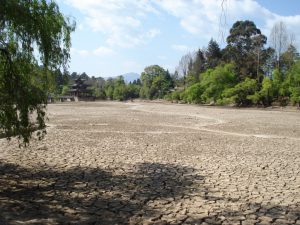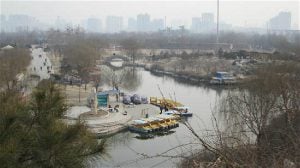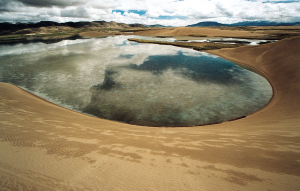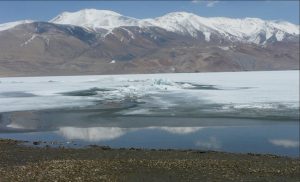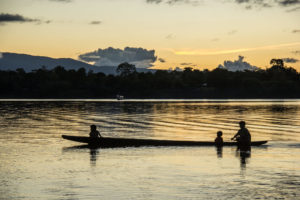Last year a proposal to divert the Brahmaputra, one of Asia’s major rivers, from Tibet into Xinjiang province was posted online, causing quite a buzz.
It’s the sort of crazy idea that pops up in China now and then. Others include blowing a hole in the Himalayas to bring warm Indian Ocean winds, and taking water from the Bohai Sea, the innermost gulf of the Yellow Sea in north-eastern China, across the country to Xinjiang.
The problem with these proposed mega-projects is that they fail to give even the most basic consideration to social and environmental consequences. What will be lost under rising waters? What are the consequences of resettling people? And what of the cultural damage?
The inventors of such schemes seem to work on a map free of people. Erase a mountain range here, draw a river in there. Their schemes are not worthy of consideration. But in a society with low levels of environmental awareness and scientific training, these ideas actually garner attention, are even welcomed. And so it is necessary to offer a simple rebuttal.
Water transfer controversy
The idea of taking water from Tibet and into Xinjiang was an offshoot of work on the western route of the South-North Water Transfer Project. The scheme had three planned routes; east, central and west. The eastern and central routes are complete, but feasibility studies for the western route are still being carried out. The aim would be to redirect water from the Yangtze to the Yellow River.
However, as the Yangtze riverbed lies between 80 and 500 metres lower than that of the Yellow River a series of dams would be necessary on the Tongtian, Jinsha, Yalong and Dadu rivers, as well as many tributaries, to raise the water to a point where it could flow naturally to the Yellow River. Most of these dams would need to be 150 metres or more in height, with the highest 292 metres. It would also be necessary to build a series of tunnels across watersheds – the longest of which would be 164 kilometres.
Experts and the public have always been sceptical about the feasibility of this engineering project. Construction would have to take place at an altitude of 3,000-4,000 metres in frozen conditions, with poor transportation and amid complex terrain. The region is prone to geological disasters, its environment is vulnerable, and it is home to ethnic and religious minorities. The costs of construction and maintenance, as well as the environmental and social costs, would be huge.
Furthermore, the natural water supply would be insufficient for the demands of the project. Even if the planned quantities of water were transferred it would not be enough to supply the needs of the arid and semi-arid north-west. But it would have a huge negative impact on the downstream ecologies of the Yangtze. Even if environmental and social costs are ignored, the construction and maintenance costs alone mean the scheme is not feasible.
But even grander plans are afoot, which date back to the 1950s when China’s authorities considered a number of schemes to supply China’s north-west with water from the Brahmaputra, Nu and Lancang rivers, as well as the upper reaches of the Yangtze. In those days there were no worries about environmental or social costs, about protecting the water supply or about what such use of water would mean for sustainable development.
But tentative plans for the western route of the South-North Water Transfer Project, put forward by the Ministry of Water Resources’ Yellow River Conservancy Commission early this century, only considered the Yangtze as a potential water source. They did not consider taking water from a wider area to be feasible.
The Shuotian Canal
Those plans were considered by specialist bodies, experts and government and were, at least, a somewhat professional discussion. The “Shuotian Canal” proposal talked up around 2006 was somewhat more fantastical.
The Shuotian Canal – referring to plans to bring water from Tibet to the rest of China, as proposed by Guo Kai and others – would see water taken from further west, from the Lancang, Nu and Brahmaputra. Dams would be built to raise the water level, then tunnels dug across the watersheds, thereby channelling the water flow directly into the Yellow River.
Former Minister for Water Resources Wang Shucheng and the hydrologists Pan Jiazheng and Qian Zhengying, who worked on the Three Gorges Dam, have all been explicit in their opposition to the idea.
According to Pan: “In the past we emphasised the conquering and rebuilding of nature, but we’ve seen many losses and built up a lot of debt. It’s time to realise we can’t just keep taking from nature – we need to learn to adapt to it, to live in harmony with it. Ideas like taking water from Tibet to Xinjiang, or opening up a pass in the Himalayas to bring in warmer winds from the Indian Ocean, are better left in science fiction novels. These are nonsensical fantasies.”
The 2017 revival
The latest version of the plan is particularly mind-boggling.
It includes a 750-kilometre tunnel traversing the Qinghai-Tibetan Plateau, from the river’s Great Bend to Golmud; and a number of tributary tunnels to bring in water from the Parlung Tsangpo; the Nu and the Tongtian rivers. It claims water will flow naturally towards Golmud, but the altitude at the start of the tunnel is less than 2,000 metres – and Golmud is at 2,700 metres. It is unclear how water will flow uphill.
The mountain valleys of south-western Tibet are prone to earthquakes and rock and mudslides. This is particularly the case at the Great Bend, where history records numerous strong earthquakes and landslides damning the river and causing flooding. The environmental and economic costs of such a huge project here are hard to imagine.
Rivers need a certain amount of water to supply their ecosystems and the needs of sustainable development for local societies – it is generally thought that no more than 30-40% of a river’s natural flow should be exploited. These schemes would see unreasonable quantities of water diverted from the rivers – 83.3% to 91.5% in the Shuotian Canal proposal. The more recent proposal does not give a specific figure, but says “most” or “all” water from the source rivers will be taken.
The rivers involved all flow across international borders. In 1972 the Declaration of the United Nations Conference on the Human Environment stated that: “States have, in accordance with the Charter of the United Nations and the principles of international law, the sovereign right to exploit their own resources pursuant to their own environmental policies, and the responsibility to ensure that activities within their jurisdiction or control do not cause damage to the environment of other States or of areas beyond the limits of national jurisdiction.”
The 1992 Rio Declaration on Environment and Development reaffirmed that principle and stressed that development, particularly joint development, is important. The architects of these plans show nothing but ignorance and arrogance regarding the concept of international rivers.
Both plans repeatedly use water shortages in northern China as a justification, but this is a mistake.
Some parts of the north are semi-humid, and even in some arid and semi-arid areas glacier melt creates fertile zones, such as the Hexi corridor and Xinjiang. Many water shortages are due to environmental damage, often arising from inappropriate human activity or misuse of water resources.
It is also the case that ecosystems form according to the resources available; demand arises according to supply. To increase supply to meet demand is a mistake. We cannot steal from one place to make up a shortage elsewhere, nor can we reallocate natural resources and change the natural environment at will. We will fail to achieve our goals and ultimately pay a huge price.
These schemes claim they will remake China and turn deserts into farmland. But the scientific foundation and the authors’ understanding of nature show they are using imagination in place of facts and fantasy in place of science. We must ask ourselves: Why do so many people seem to regard these schemes as feasible?

